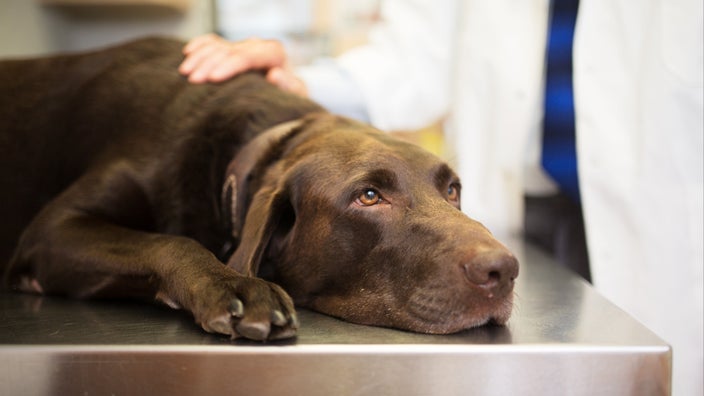
Dog Vomiting: 18 Reasons Your Dog May Be Throwing Up (Plus How to Treat)
Key takeaways:
In most cases, dogs vomit to expel food they shouldn’t have eaten in the first place. In other cases, dog vomiting could mean something more serious that needs medical attention.
If your dog vomits once and is otherwise acting normal, you can hold off on feeding them for several hours and then keep their diet bland for 24 to 48 hours.
If your dog continues to vomit and has other symptoms, such as sluggishness and loss of appetite, consult your veterinarian about diagnosis and treatment.
Table of contents

Nothing gets a pet parent out of bed quicker than the sound of their dog about to vomit. Typically, dogs vomit to expel food they shouldn’t have ingested. For instance, when a dog accidentally eats mushrooms or chocolate, their body may reject the toxic substance and push it out. Just keep in mind you still need to call your veterinarian or a pet poison hotline even if your dog vomits after eating something toxic.
Occasional vomiting usually isn’t something to worry about, especially when your dog returns to their usual playful self within 24 hours. But if a dog continues to vomit and has other symptoms, something more concerning might be going on.
Why is your dog vomiting?
Vomiting in dogs can be caused by many things. Some aren’t cause for concern, but others may require medical attention. Here are 18 reasons your dog may be throwing up.
Save on the top 10 pet medications
Save big on common pet medications like Fluoxetine and Levetiracetam at your local pharmacy.

GoodRx is NOT insurance. GoodRx Health information and resources are reviewed by our editorial staff with medical and healthcare policy and pricing experience. See our editorial policy for more detail. We also provide access to services offered by GoodRx and our partners when we think these services might be useful to our visitors. We may receive compensation when a user decides to leverage these services, but making them available does not influence the medical content our editorial staff provides.
1. Eating too fast
Dogs can sometimes get overly excited about mealtime. And when they eat too fast, it can lead to vomiting. Often, this is a one-time thing, and then the dog goes about their day. If it becomes an issue, however, slow-feeders or puzzle-feeders can help speedy eaters.
2. Eating grass
It’s usually not cause for concern if your curious pup likes to munch on grass from time to time. But if your dog eats too much grass, it can lead to vomiting.
3. Changing food too fast
Dogs can be sensitive to diet changes, especially if the changes are made too fast. Changing food too quickly can result in vomiting. So, when it’s time to switch your dog to a new food, do it gradually over 1 to 2 weeks or longer.
4. Intestinal worms
Vomiting is a common symptom of intestinal worms in dogs. Other signs of worms in dogs include:
Diarrhea
Weight loss
Low energy
Itching or scratching
Scooting their butt on the ground
Keep in mind that puppies are usually more at risk for having worms.
Poisonous for pups: Keep your curious canine out of these human foods that are toxic to dogs.
Beat motion sickness: Dogs can get motion sickness just like humans. Here are some great ways to help your nauseous pup.
Cerenia for dogs: Cerenia (maropitant citrate) is commonly prescribed to treat vomiting and nausea in dogs. Learn everything you need to know about the medication.
5. Viral infections
Viral infections can also cause dogs to vomit. Canine parvovirus is one of the infections that often lead to vomiting in dogs. Usually, this type of vomiting comes on suddenly, and it can be severe.
Other symptoms of parvovirus include:
Fever or low body temperature
Loss of energy
Lack of appetite
Stomach pain and bloating
Severe and bloody diarrhea
Read more like this
Explore these related articles, suggested for readers like you.
6. Eating things they shouldn’t
Vomiting serves, in part, as a way to protect your dog’s system from toxins. So if your dog eats something they shouldn’t — such as certain foods and things outdoors — they may throw up.
Ingesting toys or other inedible substances can also lead to vomiting. In this case, your dog’s body is trying to dislodge the foreign object blocking their digestive system.
7. Food sensitivities and allergies
Some dogs develop food sensitivities or allergies to certain types of foods or proteins. In addition to itchy skin, dogs with a food allergy or sensitivity may also have digestive symptoms such as vomiting. In fact, food intolerance is one of the most common causes of chronic, periodic vomiting in dogs.
8. Motion sickness
As with people, motion sickness in dogs can lead to vomiting. Other telltale signs that your dog has trouble with motion sickness include whining, drooling, or yawning while they’re in the car or another moving vehicle.
9. Pancreatitis
Pancreatitis occurs when a dog’s pancreas becomes inflamed. The pancreas is an organ next to the stomach that aids in digestion. When the pancreas becomes inflamed, it can cause vomiting.
Pancreatitis can also cause:
Diarrhea
Nausea
Stomach pain
Low energy
Reduced appetite
10. Inflammatory bowel disease
Dogs can develop inflammatory bowel disease (IBD), which can lead to chronic vomiting. IBD causes inflammation in the sensitive digestive tract. Dogs who have inflammation in their stomach and upper sections of the small intestine are more prone to vomiting.
11. Medication side effects
Certain medications for dogs can cause vomiting as a side effect. In fact, it’s a fairly common side effect of many medications for dogs.
Examples of medications that can lead to vomiting include:
Meloxicam (Metacam)
Rifampin (Rifadin)
Furosemide (Lasix, Salix)
Metronidazole (Flagyl)
Trilostane (Vetoryl)
Fluoxetine (Prozac, Reconcile)
12. Fever
Dogs can develop a fever for a number of reasons. But vomiting can be one sign your dog’s temperature is running high.
13. Heatstroke
If your dog is out in the heat too long, they can develop heatstroke. Heatstroke is a life-threatening condition that can lead to vomiting, as well as:
Excessive panting and drooling
Inability to stand
Increased heart rate
Dry nose
Weakness
If your dog shows signs of heatstroke, take them to an emergency veterinary hospital for treatment. Heatstroke can be fatal if not treated.
14. Liver disease
Liver disease can cause vomiting in dogs, though this is a less common cause of vomiting. Other signs that could indicate liver disease include:
Weakness
Lack of energy
Diarrhea
Weight loss
Excess thirst and urination
15. Stroke
Vomiting, on its own, doesn’t indicate that a dog has had a stroke. But if a dog has a stroke and develops balance issues as a result, they may vomit due to nausea.
Common signs of a stroke in dogs include:
Lack of balance
Aimless circling
Loss of body control
Back-and-forth eye movements
Inability to blink normally
Head tilt
Weakness, usually on one side
A stroke is an emergency situation. If your dog shows signs of having a stroke, take them to your veterinarian or an emergency animal hospital right away.
16. Addison’s disease
Addison’s disease occurs when a dog’s adrenal glands aren’t working as they should. As a result, the dog doesn’t produce enough of the hormones cortisol and aldosterone. Though it’s a less common reason for vomiting, Addison’s disease can cause dogs to throw up.
Other signs of Addison’s disease in dogs include:
Diarrhea
Increased thirst
Loss of appetite
Lack of energy
Weight loss
17. Kidney failure
In the early stages, the most common signs of kidney disease in dogs are increased thirst and urination. But as the disease progresses to kidney failure, dogs may also experience vomiting, along with:
Loss of appetite
Diarrhea
Bad breath
Lack of energy
18. Gastric motility disorders
Gastric motility disorders are conditions that cause a delay in food moving through a dog’s digestive system. These conditions can affect a dog’s esophagus, stomach, small intestine, or colon. Throwing up is the most common symptom of a gastric motility disorder in dogs. But it’s a less common reason that dogs vomit.
What does the type and color of your dog’s vomit indicate?
The color of a dog’s vomit can be telling. Different types of vomit come with varying colors and textures that give insight into the cause.
Green vomit
If the vomit is green in color, your dog likely ate grass or other plant material that upset their stomach.
Yellow vomit
“Yellow vomit is typically due to bile from the small intestine getting mixed with stomach contents during the vomiting process,” Stephanie Sheen, DVM, a veterinarian and former director of veterinary medicine at Fuzzy Pet Health, told GoodRx Health. This occurs when the stomach has already been emptied from multiple bouts of vomiting.
White and foamy vomit
White, foamy vomit, Sheen said, is caused by the mucous material lining the esophagus coming up with the vomit. This can indicate a buildup of stomach acid and mean your dog is vomiting on an empty stomach.
Undigested food in vomit
Your dog may also throw up undigested food. This could mean their intestinal tract is blocked, such as with a toy or other foreign object, Sheen said. Alternatively, it could indicate that they became nauseated close to mealtime. In other words, your dog already felt sick before they started eating and then vomited soon after.
Bloody vomit
Bloody vomit can mean that the lining of your dog’s stomach or esophagus has been damaged. This could be caused by inflammation from throwing up many times or from ulcers. If the amount of blood is significant, Sheen said, “it can indicate a clotting disorder — for example, as a consequence of eating rat bait.”
Seeing blood in your dog’s vomit is considered an emergency. If this occurs, take your dog to the ER right away.
How can you treat dog vomiting?
If your dog is throwing up, there are few things you can do to help settle their stomach.
Feed them a low-fat diet
If your dog vomits, you can try feeding them food that’s low in fat and easy to digest, such as skinless chicken breast or lean ground turkey, Sheen said. The food needs to be cooked without any spices or oil and should be mixed with a simple carbohydrate, such as white rice or cooked potatoes.
Avoid giving your dog high-fat items, including peanut butter or eggs, after they vomit. “These foods are more likely to worsen digestive upset, as they are more difficult for the body to process,” Sheen said.
Make sure they’re drinking water
Since water is lost during vomiting, provide your dog with plenty of fresh water if they’re throwing up, so they don’t become dehydrated. But make sure your dog is not drinking too much water at once, because this can also cause them to vomit. Provide your pup with small amounts of water at a time.
Ask your veterinarian about medication
Depending on the cause of your dog’s vomiting, your veterinarian might prescribe medication to reduce vomiting. One medication that’s often given to dogs for this purpose is Cerenia (maropitant citrate). It’s available as an injection that’s given by your veterinarian or in pill form.
What if your dog is throwing up but acting normal?
If your dog throws up once and otherwise acts normal, try withholding food for about 12 hours to give their tummy some rest, Sheen suggested. After that, you can feed them a bland diet consisting of boiled chicken and white rice for the next 24 to 48 hours.
Keep an eye on them to see if the vomiting stops. Often, dogs throw up due to eating something they shouldn’t. And their body is doing what it needs to do to get rid of the toxic substance.
Sheen does not recommend withholding food for very young puppies and small dogs. The same goes for dogs who need food on a regular schedule because of chronic conditions, such as diabetes. Not eating food may cause dogs with diabetes to have difficulty maintaining their blood sugar levels.
When should you worry about your dog vomiting?
It’s time to worry about your dog vomiting if you think they ingested something poisonous, they’re vomiting repeatedly, or they have additional symptoms.
You should take your dog to the emergency room if they:
Have multiple episodes of vomiting
Vomit more than once a week
Act lethargic
Lose their appetite
Stop drinking water
Develop diarrhea
Have unexplained weight loss
If you think your dog ate a toxic substance, call a pet poison hotline. An expert will request information about the toxin(s) your dog may have eaten. This helps them determine toxicity levels, provide an assessment and recommend next steps. Keep in mind that there is a fee for these services.
If your dog has vomited more than once and you’re not sure whether they ingested something toxic, seek medical advice from either your veterinarian or a telehealth service. They can help you determine what steps to take next.
Just keep in mind that many telehealth vets can’t diagnose or prescribe treatment without an established veterinarian-client-patient relationship (VCPR). So your dog may still need to be seen in person for appropriate treatment.
What can you do to prevent your dog from vomiting again?
According to Sheen, regular preventive care helps avoid infectious causes of vomiting and allows any underlying health issues to be caught early. Preventive care for your pup should include:
Deworming treatments and preventatives
Annual and semiannual (once they reach senior age) veterinary checkups
It’s also a good idea to keep an eye on your dog when they play with toys to make sure they aren’t swallowing pieces that could lead to blockages. Dogs are naturally curious creatures. They often explore their surroundings with their mouths, especially when they’re young.
Be sure to keep harmful substances — such as toxic plants, cleaning supplies, and rodent bait — away from dogs. And be careful about feeding them food scraps at dinnertime. Certain items, including chicken or turkey bones and fatty meat, can cause an upset stomach.
According to the FDA, the following common edible and inedible items can be dangerous for your dog:
Alcohol
Avocados
Caffeinated substances
Grapes and raisins
Mothballs
Antifreeze
Paints
Solvents
The bottom line
As with humans, vomiting in dogs is a natural part of life. But it’s important to monitor your dog to get to the bottom of what’s causing the vomiting. If it’s a one-and-done situation, at-home care may be enough. This includes withholding food for 12 hours and then feeding them a bland diet. However, if your dog vomits more than once within 24 hours, it could be a more serious issue that needs medical attention.
Look for other symptoms that can be cause for concern, including having low energy, not eating or drinking water for long periods of time, or having diarrhea. If your dog has repeated vomiting or if at-home remedies don’t work, seek help from your veterinarian.
Why trust our experts?



References
American Veterinary Medical Association. (n.d.). The veterinarian-client-patient relationship (VCPR).
Armstrong, P. J. (2013). GI intervention: Approach to diagnosis & therapy of the vomiting patient. Today’s Veterinary Practice.
Brooks, W. (2022). Addison's disease (hypoadrenocorticism). Veterinary Partner.
Brooks, W. (2023). Inflammatory bowel disease in dogs and cats. Veterinary Partner.
Gfeller, R., et al. (2023). Diarrhea and vomiting: First aid. Veterinary Partner.
Halliwell, R. E. W. (2002). Diagnosing, treating and preventing food allergy. World Small Animal Veterinary Association.
Jergens, A. E. (2020). Diagnosis and management of GI motility disorders. dvm360.
Llera, R., et al. (n.d.). Chronic kidney disease in dogs. VCA Animal Hospitals.
Peregrine, A. S. (2018). Gastrointestinal parasites of dogs. Merck Veterinary Manual.
Tams, T. R. (2003). The vomiting dog — Diagnosis. World Small Animal Veterinary Association World Congress Proceedings.
Twedt, D. C. (2014). Chronic vomiting patients. World Small Animal Veterinary Association World Congress Proceedings.
U.S. Food & Drug Administration. (2023). Potentially dangerous items for your pet.
Webb, C. B. (2018). Vomiting in dogs. Merck Veterinary Manual.
Williams, K., et al. (n.d.). Vomiting in dogs. VCA Animal Hospitals.





























